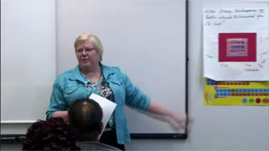Teachers' Domain - Digital Media for the Classroom and Professional Development
User: Preview



Adult education instructors Pat Marshall and Elizabeth Dinkins use pre-teaching techniques and everyday items to introduce a lesson on fractions and ratios.
These resources are part of KET’s Teaching Strategies collection.
Differentiation in the ABE Classroom: Teacher Interview: Pre-Teaching (Video)
Differentiation in the ABE Classroom: Teacher Interview: Adapting Lessons (Video)
Differentiation in the ABE Classroom: Teacher Interview: Benefits of Differentiation (Video)
Did you know you can teach without saying a word? Or that learning can begin the moment your learners enter the classroom? If you employ pre-teaching strategies, you can accomplish both of these objectives and more. Pre-teaching can act as a "hook" to get your learners' attention and begin the process of connecting prior knowledge with new concepts. Effective pre-teaching sets the tone for your class and lets learners know what to expect.
Because some pre-teaching activities, such as bellwork and graffiti boards, do not require your direct involvement, learners are encouraged to develop both independent and cooperative learning strategies. Each of these techniques is best implemented at the beginning of class, so learners are prepared to work right away.
Other pre-teaching techniques require your involvement but still serve to establish context and direction for your learners. For instance, a review of the previous lesson followed by an overview of the day’s agenda ties concepts together and lets learners know what to expect. Clear learning goals help learners to stay focused and measure their progress, while outlining future lessons enables them to see how the topic of the day relates to their learning goals.
 Loading Standards
Loading Standards